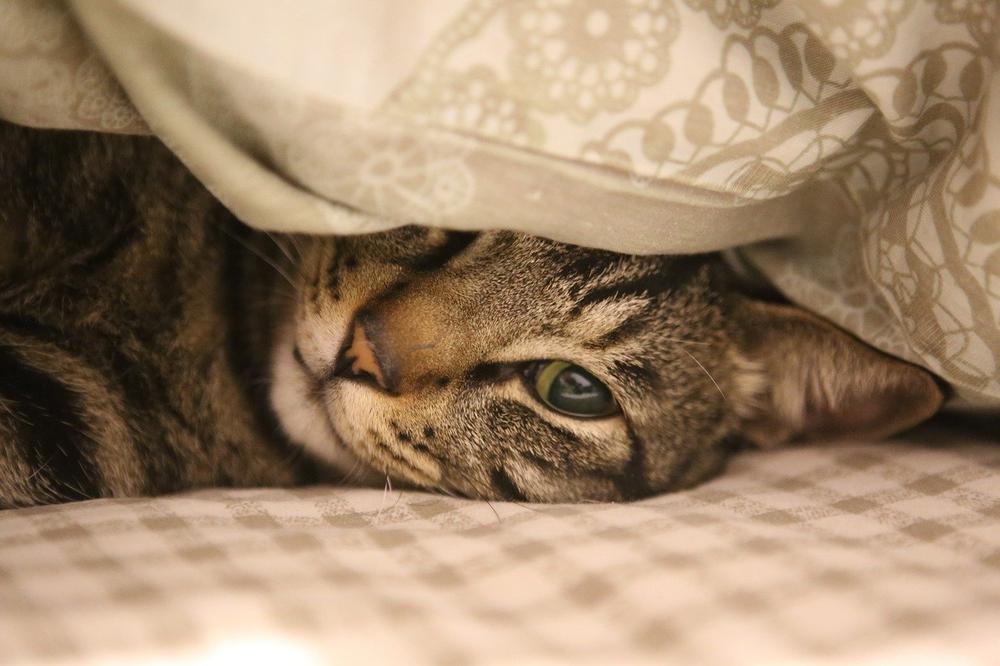How to Find a Cat in Your House? (These Tricks Always Work)

Lost your feline friend in the labyrinth of your home?
Heart racing, palms sweaty, and thoughts racing?
We've all been there before, trust me.
Now, let's embark on a wild quest together, armed with determination and a sprinkle of hope. 😊
Let the search begin.
How to Find a Hiding Cat
Okay, let's find that hiding cat! 😺
If your cat is playing a sneaky game of hide-and-seek, here are some tips to track them down:
- Start by using scented markers or crayons to draw on surfaces around the house. The strong scent can attract your cat's attention and lure them out.
- Check all the common indoor hiding places, like under furniture, behind books or drapes, and inside closets, drawers, and electronic appliances. Cats love tight spaces, so don't forget to explore crawl spaces, on top of tall entertainment units, and behind furniture.
- To aid in your search, try using a flashlight at night. This will illuminate dark corners and make it easier to spot your cat's gleaming eyes.
- Remember to stay calm and patient. Cats can be masters of disguise and may take their sweet time coming out of hiding. Take deep breaths and remain persistent.
- Don't underestimate the power of a thorough search. Check every nook and cranny, including walls and open pipes in case your cat got trapped somewhere.
- Keep an eye out for unexpected hiding spots like chest of drawers, gaps behind appliances, or even inside washing machines and dryers. Cats can find the most unconventional places to hide!
- Expand your search to the outside of the house as well. Look under decks and porches, as your cat might have taken its adventure outdoors.

If you're wondering why your cat is specifically hiding in the closet, I've written a helpful guide just for you.
Redirect your worries by exploring my article Why Is My Cat Hiding in the Closet to uncover possible reasons behind this peculiar behavior.
Luring Out a Lost Cat
To bring back your lost cat, you have to create a comforting environment.
Here are some practical tips for you:
- Put familiar scents around: Leave your cat's bed, blanket, or even your clothes with your smell where they were last seen. This will make them feel more secure and encourage them to come out.
- Tempt them with strong-smelling food: Use delicious aromas like tuna or cooked chicken to entice your cat. Warming up the food will spread its scent throughout the house, which can coax a hungry cat to venture out.
- Offer food and water outside: If your cat is on the run, leaving food and water outside at night can be an inviting gesture to lure them back home.
- Try a humane trap: In some cases, if your cat is hiding in a secluded spot, using a humane trap may be necessary to safely catch them.
- Seek help from a pet detective: When everything else fails, consulting an expert pet detective can significantly increase your chances of finding your cat.
- Use coaxing tactics: Entice the cat with food treats and use sounds associated with mealtime, like an electric can opener or shaking a bag of cat treats. These tactics might give positive results.
Approach the cat with calmness and patience to avoid scaring them away.

By applying these techniques, you'll be well on your way to locating your furry friend.
But what do you do once your lost cat finally reappears?
Well, providing them with a safe and comfortable space is crucial for their smooth transition back into the household...
What to Do When You’ve Found Your Cat
Create a cozy spot for your kitty to come home
So, you've found your beloved cat!
That's fantastic news.
Now let's make sure they feel safe and comfy as they transition back into your home.
Find them a small, secure room where they can unwind and relax.
Set up a little haven filled with familiar things - their bed, toys, food, and water.
Making this space will help them adjust after being away.
Out from the walls and into safety
But what if your cat is trapped inside the walls?
Yeah, it happens sometimes. If that's the case, cutting a hole in the drywall might be your gentle way out.
Just be careful not to hurt yourself, please!
However, if you're still unable to locate your feline friend, try not to panic.
I understand it's easier said than done, but stay calm.

Seek assistance from specialized services that deal with lost or missing pets.
You might want to ask your neighbors if you can search around their homes or properties, just in case your curious kitty decided to explore that area.
Taking a personal approach is vital.
Instead of merely stapling fliers to poles, hand them out personally.
Take the time to visit local animal shelters regularly to check if your cat has been brought there.
When all else fails…
If you still haven't had any luck finding your furry companion, it may be time to reach out for further guidance.
Contact your veterinarian and local animal shelters.
They might have extra resources and suggestions on how to find your cat.
Don't hesitate to involve your neighbors too.
Should your cat have gotten outside, ask them for assistance.
Sometimes, all it takes is a kind neighbor's eye to spot your wandering pet.
And now, let's move on to some proactive steps you can take to increase your chances of finding your missing cat...
Proactive Things Pet Parents Can Do Before a Cat Goes Missing
When it comes to keeping your cat safe, being proactive is key.
Here are some proactive steps you can take before your cat goes missing:
- Regularly practice calling your cat by using their name or a specific sound cue. Reward them when they come to strengthen this behavior, which can be helpful if they ever go missing.
- Report your missing pet to appropriate platforms for assistance. They have resources and networks to help find lost animals.
- Close all windows and doors in your home to prevent your cat from escaping while searching for them.
- Think about your cat's typical behavior and search nearby houses and potential hiding spots where they may have wandered off to.
- Set up wilderness cameras in these areas to track your cat's movements and get insight into their whereabouts.
- Utilize social media platforms to spread the word about your missing cat. Many people use social media for community-based support.
- Increase the chances of being reunited with your cat by ensuring they have a collar with ID tags or are microchipped. This helps identify them if they're found.
Taking these precautions can greatly improve the likelihood of finding your missing cat.

If you're feeling anxious about the possibility of your cat going missing, I have a helpful solution for you. Check out Cat Hiding Behind Tv, where you'll find useful tips on how to prevent cats from hiding behind your TV. Trust me, it's worth a read!
And now, let me share with you a few more tips and suggestions that I find helpful when it comes to locating a missing cat.
Every cat is different, so these methods may not work for everyone.
But don't lose hope - cats have an amazing ability to find their way back home, even after extended periods of time!
Can Cats Find Their Way Home?
Place familiar scents outside, such as a blanket or litter box, to lead your cat back home using their keen sense of smell.

If your cat goes missing, don't panic. Give them time and then expand your search to the surrounding area.
Check if any doors or windows were left open—cats are expert escape artists.
Keep searching outside with hope in your heart. Cats can be gone for weeks, even months, before miraculously returning to you.
Lost Cat Myths
When your cat disappears, don't wait around hoping they'll come back.
Get out there and actively search for them.
Time is precious in these situations, so the sooner you start looking, the better chance you have of finding your furry companion close by.
Now let's clear up some misconceptions about lost cats:
- Some people think that lost cats can end up miles away from home. But the truth is, most missing cats are found within a mere 50 meters.
- So save your energy and focus on searching nearby.
- Don't waste your time mentioning specific places or languages during your search – it won't make a difference.
- Instead, concentrate your efforts in your immediate area.
- There's also this idea that indoor cats don't wander far when they escape, while outdoor cats venture off into the great unknown. Well, the reality is that whether they're indoor or outdoor cats, they tend to stay within a 50-meter radius from home.
- So don't limit your search based on this misconception.
By debunking these myths, you can optimize your search and increase your chances of a happy reunion with your four-legged friend.
Take action quickly, search nearby, and ignore those false beliefs about lost cats.
That way, you'll be able to bring your beloved kitty back home where they belong.
The Joy of Finding a Lost Cat
- Check common indoor hiding places: under furniture, behind drapes, inside closets.
- Explore tight spaces like crawl spaces, on top of tall furniture.
- Use a flashlight to search at night and remain calm.
- Check home structure, walls, and open pipes for trapped cat.
- Unexpected hiding places: gaps behind appliances, inside washing machines.
- Thoroughly search both inside and outside the house, including under decks.
- Use strong-smelling food to lure out a lost cat.
- Consider leaving food and water outside at night.
- Use a humane trap or seek assistance from a pet detective.
- Coax the cat with noises associated with mealtime.
- Turn on the air conditioning unit to help locate the cat.
- Gently cut a hole in the drywall if the cat is trapped.
- Seek help from specialized services and neighbors.
- Hand out personal fliers and contact local animal shelters.
- Report your missing pet to platforms like PawMaw.
And that wraps up today's article.
If you wish to read more of my useful articles, I recommend you check out some of these: How to Find a Lost Cat in Winter, Why Does My Cat Want to Go Outside, Stray Cat Follows You, Why Is My Cat Obsessed With My Feet, and Cat Runs Out of the Litter Box While Pooping
Talk soon,
-Sarah Davis